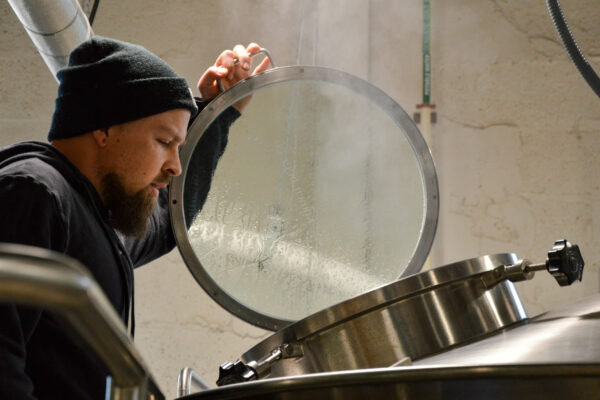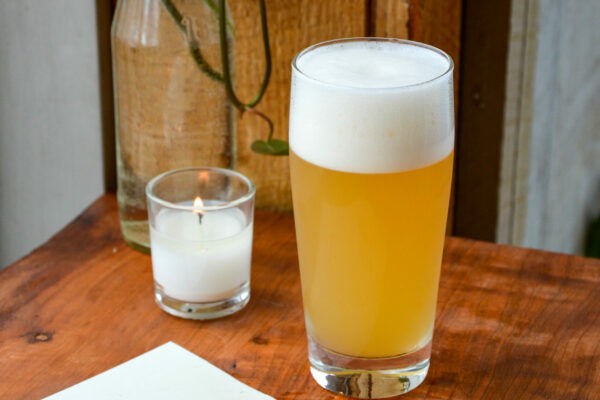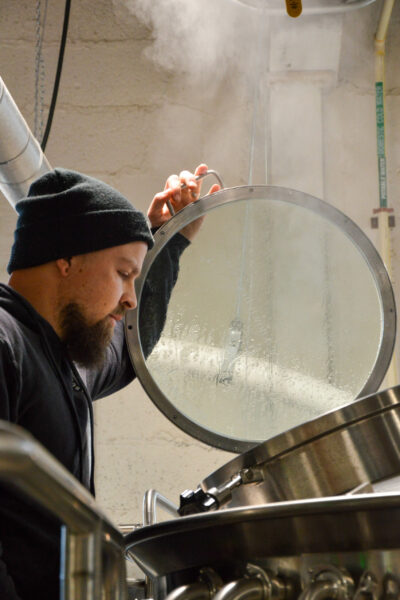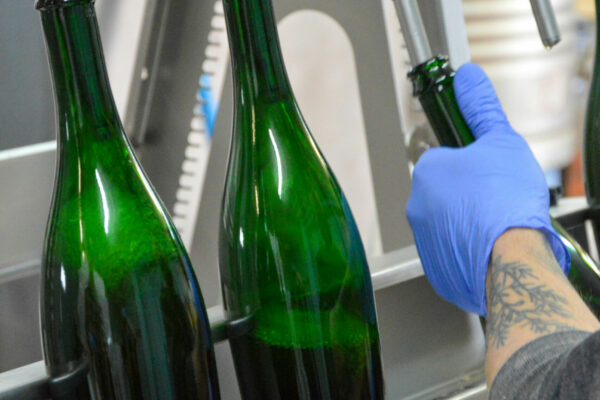
WORDS & PHOTOS | JESSE FELDBERG
Nestled into an industrial neighborhood-turned-brewery district just west of downtown Roanoke, Blindhouse Beer Company brings to the table a style all their own — both in their beer and in the means of its production. Comprised entirely of open-fermented beers, their tap list offers a different look to the neighborhood’s many thirsty visitors.
Owners Tyler Wert and Nicole Davidson-Wert had been planning a move to Roanoke to open their brewery for a few years, citing the community-minded atmosphere and the room for everyone to do their own thing. They did just that with Blindhouse, which opened its doors this past April.
Wert began his brewing journey as a homebrewer, and as with the large majority of homebrewers, there was plenty of trial and error. “[The beer] was horrible, but it was a fun process, and I was wondering how I could do it more professionally,” Wert explained. He followed the growing beer scene, moving from Maryland to Charlottesville, and then on to Richmond with the rise of some of Virginia’s most well-known breweries such as Triple Crossing, The Veil, and The Answer. Halfway through University of Richmond’s Craft Brewing Certification course, Wert landed a job as a cellarman at Triple Crossing, and after just two short months stepped up into a full-time brewing role.
From there, Wert’s interest in the unique styles of beers he produces took off. When he took over the role, there were only a few barrels filled with beer, and nobody was doing a whole lot with them. He expressed an interest in taking over the project. “I was very lucky that they put their trust in me and let me experiment and screw things up and just figure it out as I went,” said Wert. He dumped some beer, but slowly and surely figured out how to maintain the complex styles, falling in love with mixed fermentation — a method of fermenting with a combination of traditional brewer’s yeast and other unconventional fermenting yeast and bacteria.
“It was a really unique side of beer that not many people get to see but can create some of the most complex flavors that you can find,” Wert explained. “[It] runs that cool middle ground between beer and wine where you get some elements of both. I felt like it needed to be more prevalent in the industry, and that it’s still a little misunderstood by consumers as people get a little freaked out by the sour and the flavor descriptors. They can still be delicate and approachable and easy to drink.”
“The big goal was to find the balance of acidity,” said Davidson-Wert. “We’re careful not to describe them as sour beers, even though some might have that element of acidity, because there’s great sour beers but sometimes things go to an extreme.”
Akin to the unique draft offerings, Wert and Davidson-Wert produce their beers in a way that is surely not seen anywhere else in Virginia, and perhaps not nationwide. Rather than purchasing a new brewhouse — which is a substantial investment — they opted to use their beer community connections to do things differently. On brew days, Wert rents a truck and loads a stainless steel tote in the back, then drives down to Winston-Salem to Lesser-Known Beer Company, opened by a friend and former colleague from Triple Crossing. There, the wort — the sugary liquid that becomes beer when fermented — for Blindhouse is produced and “knocked out” into the tote. It is then trucked back to Salem Avenue in Roanoke, where Wert transfers it into his large, square open fermenters where the yeast is “pitched” and the open fermentation begins.
Wert explains that the pitch culture is the most important part of what makes mixed-fermentation beers so unique. The culture is typically a blend of yeast and bacteria — some combination of brewer’s Saccharomyces, Brettanomyces, Lactobacillus, and Pediococcus. “Each of those is impacting fermentation in different ways and creating unique flavors,” Wert explains. “Our specific culture was foraged from wild plants and flowers growing on some family land in Franklin County.” They often augment their naturally-foraged culture with a classic French saison yeast to get some of the traditional saison notes expressed in tandem with the unique flavors the wild yeast and bacteria bring to the table.
After about a week spent in the open fermenters, the newly-produced beer is transferred into oak barrels — mostly red wine barrels from Virginia wineries — where it will spend several weeks to months conditioning and developing flavors.
“I’m sampling those on the regular, and deciding when I feel like something’s ready, usually blending two to three barrels together in a stainless tank. From there I can dry-hop, add fruit, whatever I want to add some different character. Or just leave it alone if I feel like this is a cool expression on its own.”
“We’re always trying to complement the existing flavors in the beer,” says Davidson-Wert, “rather than overpowering with adjuncts.”
Once the beer has had a week or two to meld in stainless, it’s ready for packaging. Never force-carbonated, the beer is transferred to kegs or bottles with a small amount of sugar and yeast to naturally carbonate (similar to a sparkling wine), which takes another week or two.
The eventual goal, Wert says, is to become a fully wild-culture brewery, replacing commercial yeast with their own foraged and banked cultures, which continue to evolve on their own. While it may be outpaced by the traditional saison yeast in the younger beers, Wert excitedly expects the wild culture to be more prevalent as he gets into the older stock of barrels and warmer-temperature fermentations as the seasons change.
The name, Blindhouse, was found in an Appalachian word dictionary and defined as a “windowless cabin.” Wert and Davidson-Wert liked the name and began digging around — finding out that it was co-opted from 17th/18th century Europe as a windowless stone room that town drunks would be thrown into, which they found funny and ironic. From there, they kept finding connections, from Davidson-Wert’s experience in the cabin-laden state parks during her stint with AmeriCorps to Wert describing feeling like he is “in a blindhouse” (very intensely focused) when brewing. “I like the idea of creativity within confines,” he explains. They’ve found that focusing on the narrow, niche style has bred some of the most creative and interesting expressions of beer. “Even though we’re doing it this one way, all of our beers are not the same,” adds Davidson-Wert.
All of this, from the wild yeast to starting a brewery without, well, a brewery, exemplifies a modern take of opening a business. The era of cookie-cutter breweries may not be over, but a new generation of the beer industry is emerging into the spotlight. With the right combination of passion (or nerdiness, depending which of the two you ask), community and creativity, one only needs to step into Blindhouse to discover something that is soon to be integral to beer communities nationwide.
Blindhouse Beer Company
Thurs., 4-9 p.m. Fri., 4-10 p.m. Sat., 1-10 p.m., Sun. 1-7 p.m.
534 Salem Ave SW, Roanoke, VA 24016
Note: This article originally appeared in our 2023 Summer Issue











